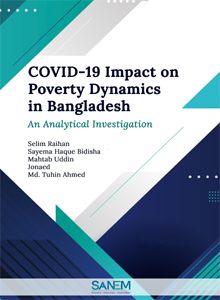COVID-19 Impact on Poverty Dynamics in Bangladesh: An Analytical Investigation
 Citation: Raihan, S., Bidisha, S. H., Uddin, M., Jonaed., & Ahmed, M. T. (2020). COVID-19 Impact on Poverty Dynamics in Bangladesh: An Analytical Investigation. SANEM Publications, Dhaka, Bangladesh.
Citation: Raihan, S., Bidisha, S. H., Uddin, M., Jonaed., & Ahmed, M. T. (2020). COVID-19 Impact on Poverty Dynamics in Bangladesh: An Analytical Investigation. SANEM Publications, Dhaka, Bangladesh.
There are paramount fears that Bangladesh’s economy might suffer from long-term anti-developmental challenges fuelled by the COVID-19 crisis. One of Bangladesh’s decade-long development achievements, the massive reduction in poverty rates, might dissolve with prolonged economic downturns. This study, therefore, investigates the impacts of the COVID-19 pandemic on the poverty dynamics in Bangladesh. In this regard, this study uses a number of simulations to estimate the poverty scenario in the country under the broad assumption of a 25 per cent general income shock. Using the latest Household Income and Expenditure Survey (HIES), the most comprehensive and nationally representative data, this exercise finds that, with a 25 per cent general income shock, the overall poverty rate in the country will almost double: an increase from 20.5 per cent to 40.9 per cent. This study also finds that the increase in poverty rates due to the income shock is not homogenous across the country, even not across occupations, and industries. The Government of Bangladesh (GoB) should, therefore, take into account these poverty dynamics in its policy response. To mitigate the crisis, the GoB can expand coverage and transfer the benefits of the social safety net. Announcement and effectively implementation of sector-wise stimulus packages are also crucial. Since there is a strong geographical dimension to the poverty dynamics of the country, all policy actions should keep a special focus on these spatial dynamics.
